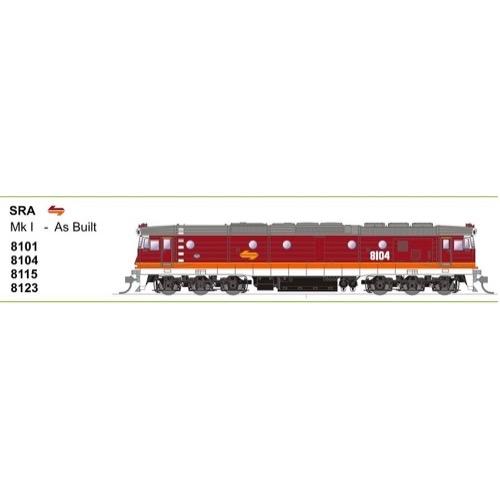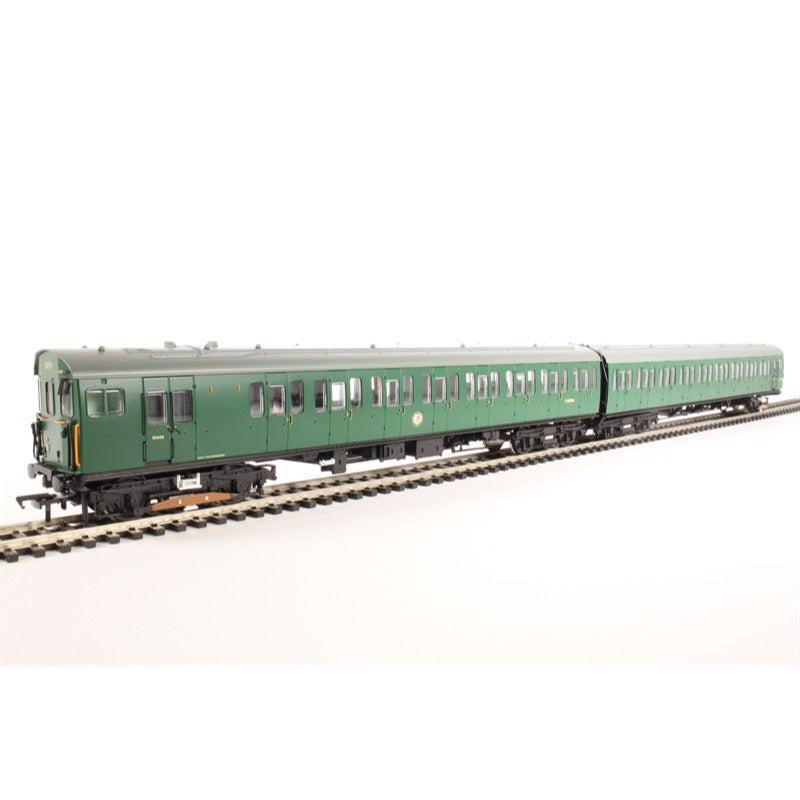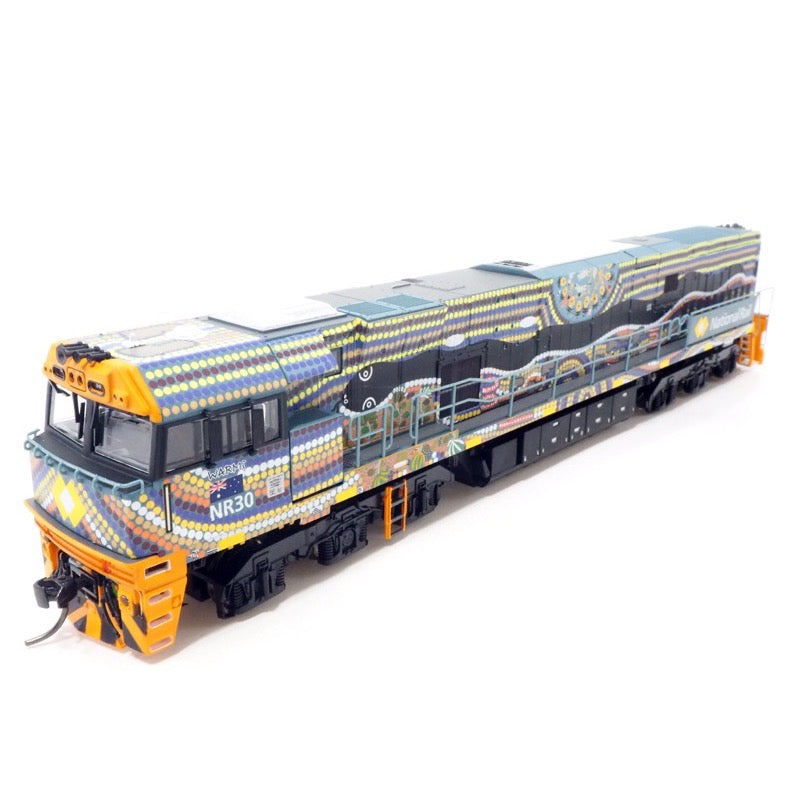
SDS Models HO NR30 National Rail Warmi Indigenous NR Class Locomotive
Introduced in 1996 by National Rail Corporation these 120 units were built by A Goninan and Co. The locomotives are 3000kw General Electric powered and used on standard gauge Australia wide.
They were introduced in grey and marigold and several were painted into various business units of NRC. Later they wore GSR train liveries representing the Hook and Pull agreement between the two companies.
In 2002 Pacific National acquired the assets of NRC and commenced to repaint the NR class into their new blue and yellow colours.
The model features the current tooling from Austrains and includes operating headlights, marker and ditch lights and is Kadee equipped. These are an ideal way to add colour to your collection.
Feature
- Highly detailed Ready-to-Run HO gauge model
- Precisely tooled plastic body (ABS)
- Genuine Kadee scale head whisker coupler
- Separately applied handrails and detail parts
- 5-Pole skew wound electric motor and dual flywheels
- All wheel drive and electrical pickup
- LED headlights, marker lights, number boxes and ditch lights
- All models come standard with an MTC 21 pin motherboard
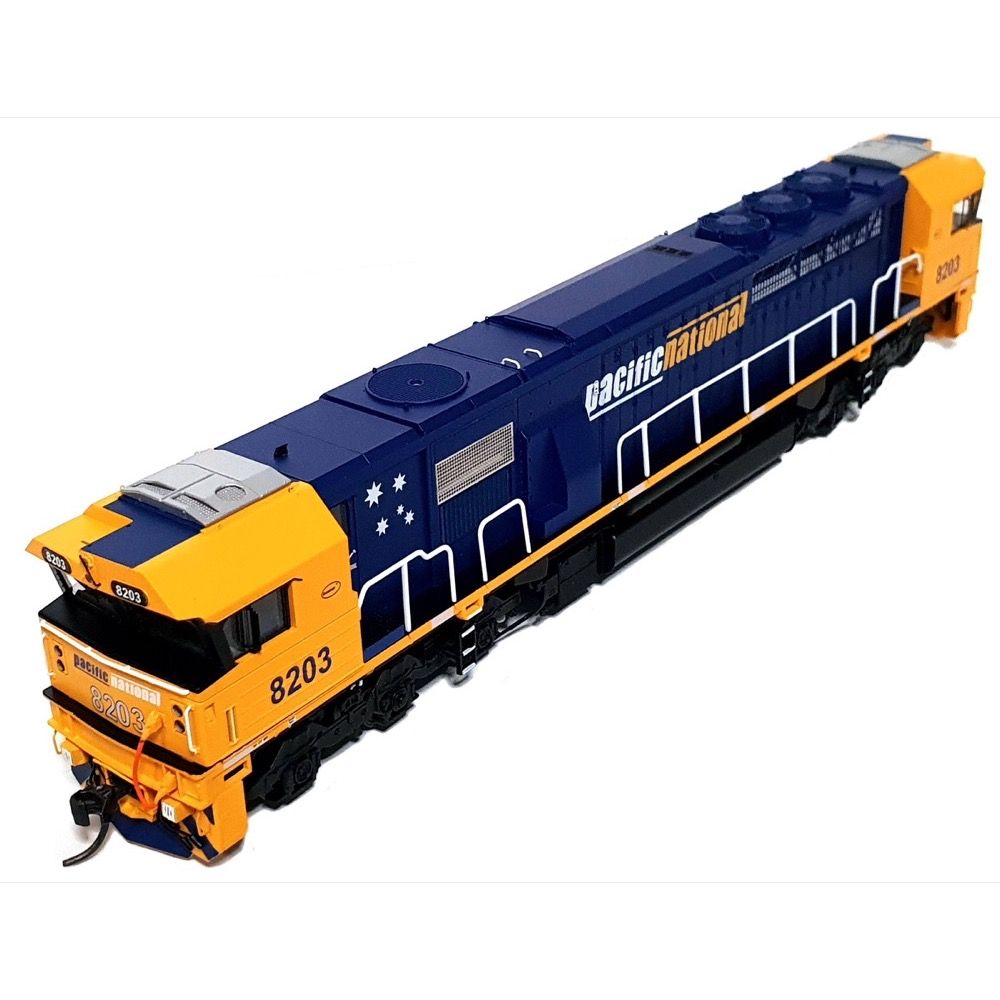
On Track Models HO 8220 Freight Rail 82 Class Locomotive
Early History of the 82 Class
March 23rd, 1994 heralded a new era in freight rail operations in Australia. On this day, Clyde Engineering in association with General Motors EMD released the first of fifty eight ‘82' Class locomotives from Clyde’s Mittagong plant.
These locomotives along with their imported cousins, the EMD Canadian built 90 class, marked a new beginning in the way a locomotive fleet was operated and maintained.
Whilst these locomotives were operated by Freight Rail (a business unit of State Rail), they are actually supplied and serviced by Clyde at their Kooragang Island maintenance facility. This leasing arrangement was known as ‘Ready Power’
Under the terms of this contract, Clyde would be responsible for the overall up keep and maintenance of these units for a period of fifteen years. Although minor servicing and provisioning was undertaken by Freight Rail, major servicing and repairs was completed by Clyde.
With the introduction of these locomotives a wide spread reduction of the NSW locomotive fleet had begun. The first casualties were the veteran fleet of 44 class Alco’s, then the 45 and 442 classes along with the Mark I 48 class. Further reductions to the locomotive occurred with the withdrawals of the 422 and 49 classes.
This overall fleet reduction reduced the average age of Freight Rail’s locomotive fleet from over twenty five year old to approximately ten.
These locomotives have travelled all over NSW and have ventured into Queensland and Victoria on intermodal freight services, and in South Australia on the Leigh Creek coal service. They are currently seen on both coal and wheat services all over the state, through Sydney, and the occasional local trip train around the Sydney metropolitan area.
On Track Models is pleased bring you this highly desired locomotive as a highly detailed model in HO Scale.
82 Class Improvements
- ESU designed PCB with two sugar cube speakers
- Independent working headlights, white and red marker lights (DCC only)
- See through Dynamic blower housing with box
- Improved one-piece MU cables
- Improved air hoses
- Improved axles bushes for better electrical pick up
- Factory Painted & Decorated in new PN livery
82 Class Model Locomotive Standard Features
- Ready-to-Run
- Scale AMRA Profile Metal Wheels
- All wheel drive - All wheel pick up
- 18" Recommended minimum radius
- Highly detailed bogies with separately applied parts
- Easy access to the DCC 21 pin plug
- Easy body removal
- Quality 5 pole skew wound motor
- Die cast metal chassis with recesses for twin speakers
- Twin brass flywheels
- Etched metal detail parts
- Separately applied metal parts
- Genuine Kadee Metal Couplers
- Detailed cab interrior
- Operational headlights, foglights, & marker lights
- Compatible with Code 70, 83, & 100 Rail
- Accurate Paint Schemes & Printing
- Factory Painted & Decorated
Photos shown are representative of the finished model. Numbers and colours may vary on final product.
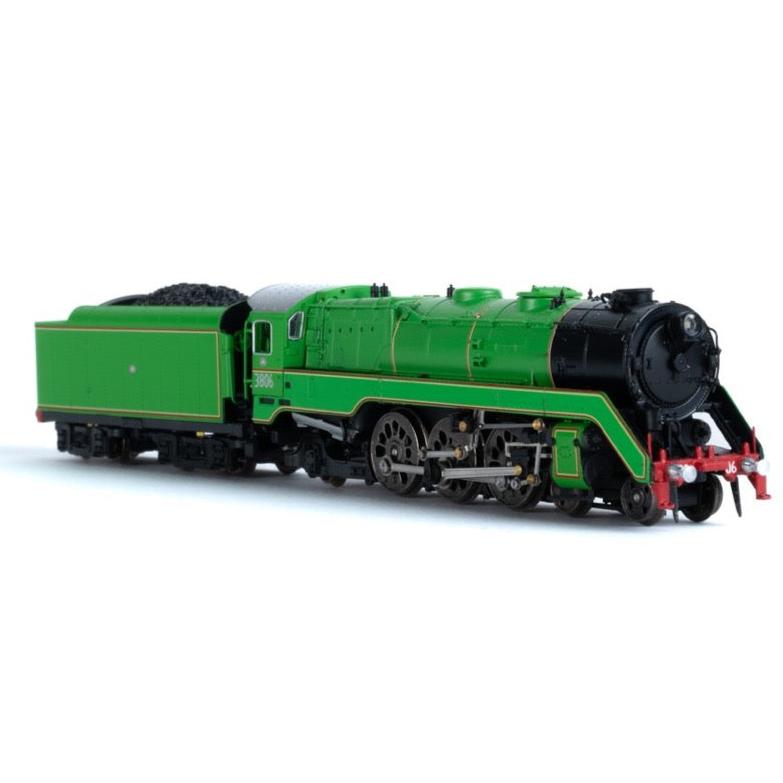
Gopher Models N Scale C38 Class Locomotive NSWGR 3806 (Green)
Gopher Models N Gauge NSW Class 38 Steam Locomotive - 3806 Edition
Discover the unparalleled craftsmanship and intricate detail of the Gopher Models N Gauge NSW Class 38 Steam Locomotive, created in exclusive collaboration with Hobbies Australia. This meticulously engineered model train embodies the heritage and technological advancements of the iconic NSW Class 38, making it a must-have for any model railway enthusiast.
38 Class: Engineering Marvel
The C38 Class locomotive, built by Eveleigh Railway Workshops, boasts impressive specifications that define its power and capability on the rails. With a wheel configuration of "Pacific" 4-6-2 and a driving wheel diameter of 5ft 9in, it exhibits remarkable traction and stability. Its substantial size, with a length of 76ft 5in and a total weight of 201 tons, ensures its presence is felt on the tracks. Equipped with a generous fuel capacity of 14 tons and a water capacity of 8,100 gallons, the C38 Class locomotive is ready for long-haul journeys. Its firebox area of 47 sq ft and boiler pressure of 245 psi enable efficient steam generation, while the cylinders, measuring 21.5in x 26in, deliver a formidable tractive effort of 36,273 lbf. The engineering marvel that is the C38 Class locomotive, embodies the legacy of Eveleigh Railway Workshops and the rich history of railroading.
Features
- 1/160 N Scale
- DC Coreless Motor
- DCC Sound Ready
- Working Headlamp
- Swivel Bogies on Tender
- Accurately reproduced motion mechanism
- Magne-Matic™ #1015 Couplers
- Min track radius 10.5in
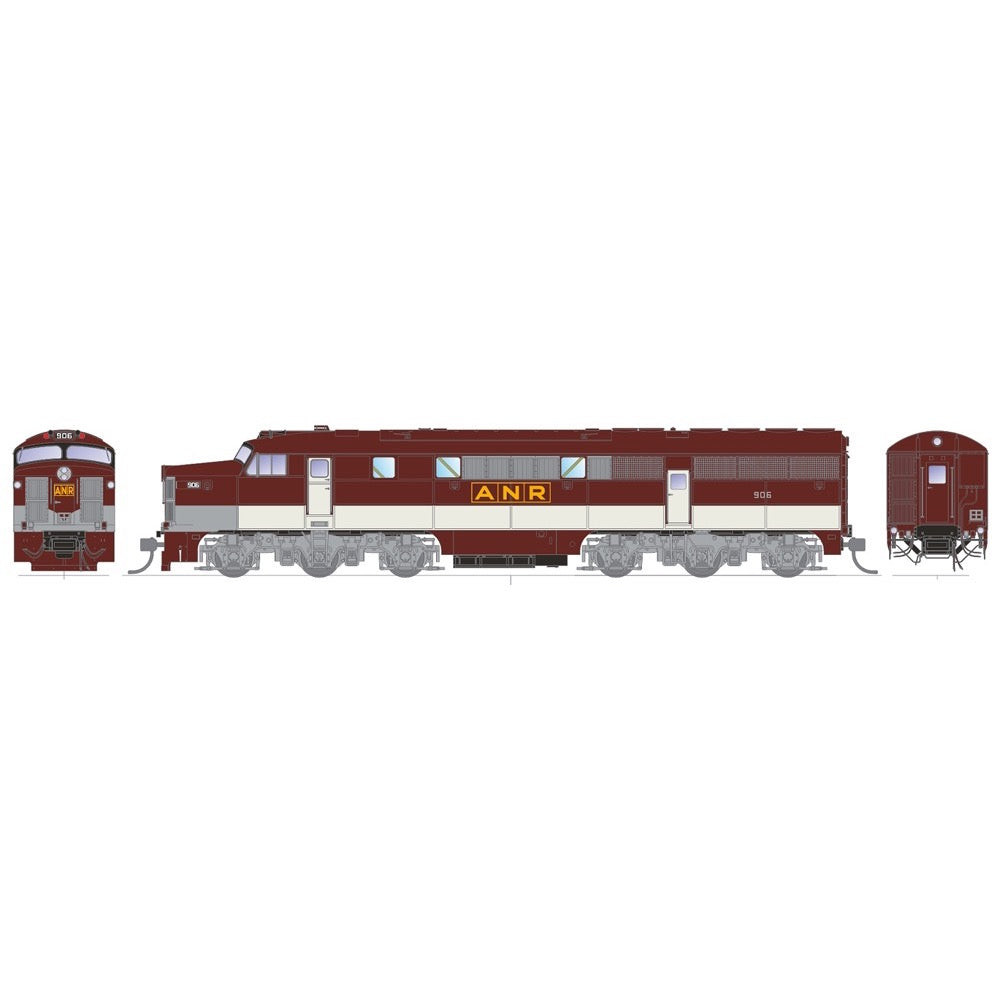
SDS Models HO ANR 900 Class Locomotive 906 DCC Ready
Arguably the first of the streamliners, and Australian built mainline locomotives. The SAR 900 class diesel-electric locomotive were designed and built in-house by the South Australia Railways, they used English Electric V16 engines. English Electric also supplied the generators and traction motors.
The 10 units were delivered between 1951 and 1953, all were out-of-service by mid 1985.
900 Lady Norrie is preserved by the National Rail Museum, she also ventured across into Victoria to appear at Spencer Street station for the Aus Steam 88 festival. 907 and 909 were operated by SteamRanger tourist railway until 1995.
We have produced 4 body variants for the 900 class:
- Early service without large forward roof hatch with single Dynamic Brake fan shroud.
- Early service with large forward roof hatch with twin Dynamic Brake shroud.
- Late service with front twin sealed beam headlight.
- Preservation with front and rear twin sealed beam light.
Features
- Highly detailed Ready-to-Run HO gauge model
- Precisely tooled plastic body (ABS)
- Genuine Kadee scale head whisker coupler
- Separately applied handrails and detail parts
- 5-Pole skew wound electric motor and dual flywheels
- All wheel drive and electrical pickup
- LED head and marker lights
- All models come standard with an MTC 21 pin motherboard
- Exclusive sound by DCCSound

Hornby Dublo R30264 OO LNER Class A4 4-6-2 4464 Bittern Great Gathering 10th Anniversary Era 10 Locomotive
The LNER Gresley A4 is one of the most iconic express locomotives in Great Britain, with its streamlined casing a classic symbol of the attitude towards speed and design in the 1930s, which saw increased competition to the railways from road and air travel. The LNER Board knew that they had to make travel between the major cities faster, comfortable and more reliable.
Nigel Gresley, the LNER's Chief Mechanical Officer, travelled on the Fliegende Hamburger diesel locomotive in Germany and was impressed by its streamlining, although he realized it was only efficient at high speeds. Gresley was certain that a modified A3 Pacific, with streamlining, could haul greater loads than other locomotives at the same speed or faster and a series of trials were conducted to confirm the A3's suitability.
With the trials successfully completed, the LNER Board gave Gresley the go-ahead to create the "Silver Jubilee" streamlined trains, the first of the new streamlined A4s.The streamlining of the A4s' steam circuit, higher boiler pressure and extension of the firebox to create a combustion chamber made them more efficient than the A3 as they consumed less coal and water- especially later on when they were also fitted with a Kylchap double chimney. This improved their free steaming capabilities further.
Their streamlined design not only made them capable of high speeds, but created an up draught of smoke, obscuring the driver's vision, a major problem on the new Class A4 engines. The story goes that during wind tunnel testing, after several unsuccessful efforts to get the smoke to lift clear, a thumbprint was inadvertently left on the clay model just behind the chimney. This succeeded in clearing the smoke and was incorporated into the final design.
4464 Bittern was rolled out of the Doncaster shed it was built in on the 18th December 1937 and entered LNER service shortly after. The locomotive would be renumbered to 60019 by BR, after its renumbering to 19 under the 1946 LNER renumbering scheme. Bittern was withdrawn on the 5th September 1966 and was destined for the scrapyard however was chosen for preservation after 60024 Kingfisher, originally selected, was found to have firebox problems.
Bittern officially entered preservation on the 12th September 1966. Bittern is currently at the One:One collection in Margate, awaiting overhaul which will take place once 60532 and 70000 are back on the mainline. In running preservation Bittern has carried the identities of some scrapped classmates such as 2509 Silver Link and 4492 Dominion of New Zealand.
Hornby Dublo A4 models feature a diecast body, just as their original Hornby Dublo counter parts would have been seen. This is coupled with enchanted decoration which when paired with the diecast of the boiler provides a realistic finish to the body. The models contain a 5 pole motor with flywheel and are DCC ready with an 8 pin socket.
Specifications
- Item Length - Without Packaging (cm): 29.1
- Item Height - Without Packaging (cm): 5
- Item Width - Without Packaging (cm): 3.5
- Item Weight - Without Packaging: 0.6
- Item Scale: 1:76 Scale 00 Gauge
- License: Yes
- License line: Produced under licence for SCMG Enterprises Ltd. © SCMGE. Every purchase supports the museum.
- Finish: Painted
- Colour: Blue
- Gauge: OO
- DCC Status: DCC Ready 21 pin socket
- Operator: LNER
- Designer: Sir Nigel Gresley
- Wheel Configuration: 4-6-2
- Livery: LNER Garter Blue
- Minimum Curve (mm): Radius 2
- Motor: 5 Pole Skew wound
- Number of Parts: 1
- Class: A4 Class
- Buffer Type: Sprung Metal Buffers
- Coupling Type: NEM Tension Lock
- Hornby Decoder Compatibility Primary: HM7000-8TXS: Bluetooth® & DCC Sound Decoder (21-pin)
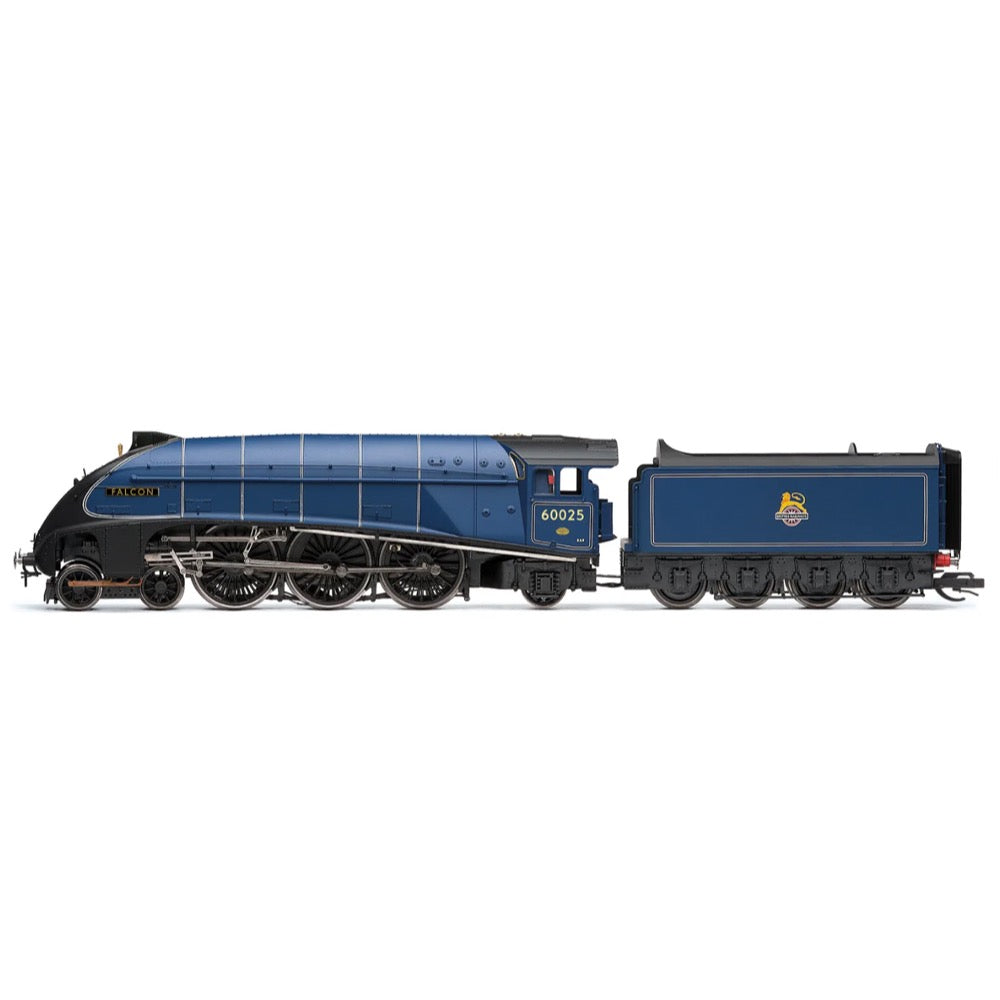
Hornby TT3009M TT BR Class A4 Class 4-6-2 60025 Falcon Locomotive
The LNER Gresley A4 is one of the most iconic express locomotives in Great Britain, with its streamlined casing a classic symbol of the attitude towards speed and design in the 1930s, which saw increased competition to the railways from road and air travel. The LNER Board knew that they had to make travel between the major cities faster, comfortable and more reliable.
Nigel Gresley, the LNER's Chief Mechanical Officer, travelled on the Fliegende Hamburger diesel locomotive in Germany and was impressed by its streamlining, although he realized it was only efficient at high speeds. Gresley was certain that a modified A3 Pacific, with streamlining, could haul greater loads than other locomotives at the same speed or faster and a series of trials were conducted to confirm the A3's suitability.
With the trials successfully completed, the LNER Board gave Gresley the go-ahead to create the "Silver Jubilee" streamlined trains, the first of the new streamlined A4s.The streamlining of the A4s' steam circuit, higher boiler pressure and extension of the firebox to create a combustion chamber made them more efficient than the A3 as they consumed less coal and water- especially later on when they were also fitted with a Kylchap double chimney. This improved their free steaming capabilities further. Their streamlined design not only made them capable of high speeds, but created an up draught of smoke, obscuring the driver's vision, a major problem on the new Class A4 engines. The story goes that during wind tunnel testing, after several unsuccessful efforts to get the smoke to lift clear, a thumbprint was inadvertently left on the clay model just behind the chimney. This succeeded in clearing the smoke and was incorporated into the final design.
4484 Falcon entered service with LNER in January of 1937, following the broad early naming format based around Gresley’s penchant for birds. The locomotive would go on to serve under BR as 60025 before being scrapped in October of 1963.
Specification
- Item Length - Without Packaging (cm): 19.1
- Item Height - Without Packaging (cm): 3.7
- Item Width - Without Packaging (cm): 2.5
- Item Weight - Without Packaging: 0.15
- Item Scale: 1:120 Scale
- Finish: Painted
- Colour: Blue
- Gauge: TT
- DCC Status: Next 18 Socket (NEM 662)
- Operator: BR
- Designer: Sir Nigel Gresley
- Wheel Configuration:4-6-2
- Livery: BR Blue
- Minimum Curve (mm): Radius 2
- Motor: 3 Pole
- Number of Parts: 1

Hornby R3866 OO BR Battle of Britain Class 4-6-2 34051 Winston Churchill
Built at Brighton Works in 1946, the locomotive was named Winston Churchill at a ceremony at Waterloo railway station in September 1947. It was allocated to Salisbury locomotive shed for services on the West of England Main Line between London and Exeter and was later re-allocated to the Nine Elms locomotive shed in London, followed by the Exmouth Junction shed near Exeter before returning to Salisbury in mid-1951.
The locomotive was used to pull Winston Churchill's funeral train from Waterloo to Hanborough in January 1965 before being withdrawn later that year on the 19th of September 1965 to be preserved. It entered into the National Railway Museum collection and has since been displayed at York and Shildon.
Specifications
- Item Length - Without Packaging (cm): 27.2
- Item Height - Without Packaging (cm): 5
- Item Width - Without Packaging (cm): 3.5
- Item Weight - Without Packaging: 0.32
- Item Scale: 1:76 Scale 00 Gauge
- License: Yes
- License line: Licensed by SCMG Enterprises Ltd. National Railway Museum logo © SCMGE.
- Finish: Painted
- Colour: Green
- Gauge: OO
- DCC Status: DCC Ready 8 pin socket
- Operator: BR
- Designer: O.V.S Bullied
- Wheel Configuration: 4-6-2
- Livery: BR Green
- Minimum Curve (mm): Radius 2
- Motor: 5 Pole Skew wound
- Number of Parts: 1
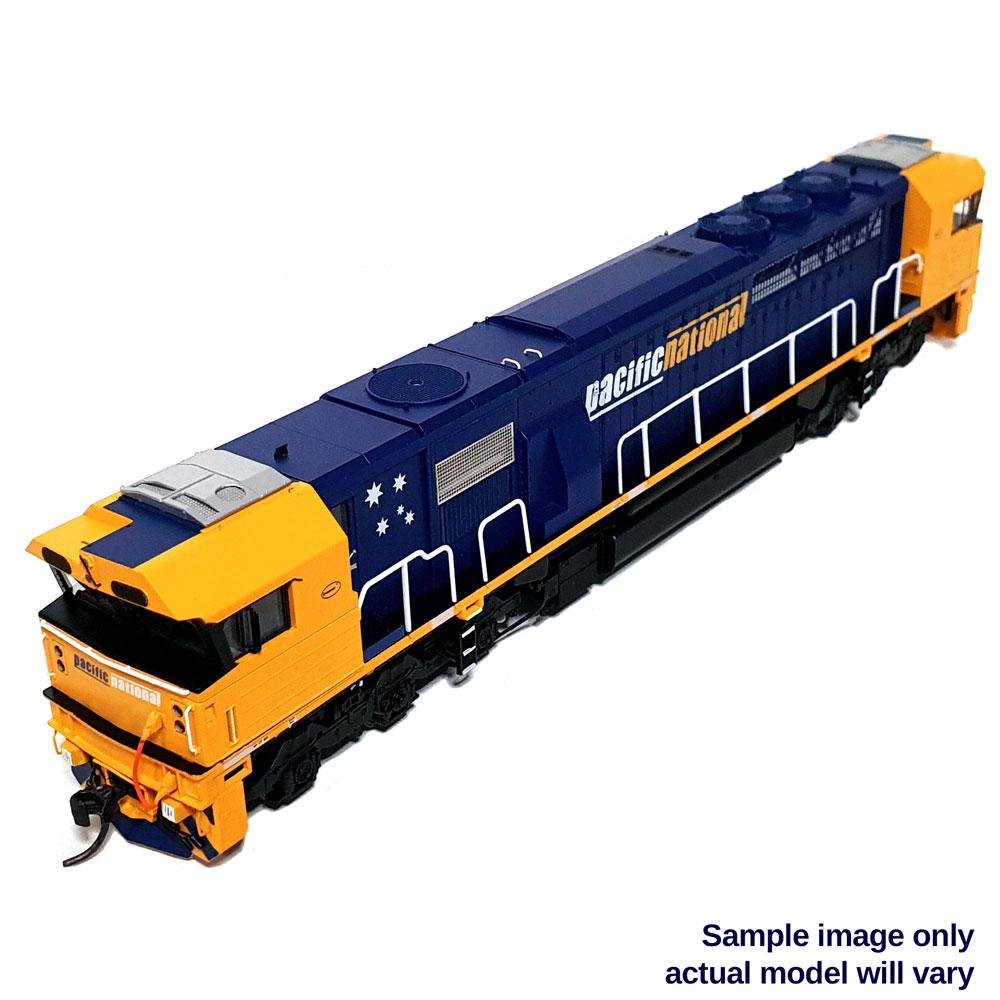
On Track Models HO 8206 Pacific National 82 Class Locomotive
Sample image supplied for illustration purposes only. Actual model will display authentic numbering and will vary.
With the introduction of these locomotives a wide spread reduction of the NSW locomotive fleet had begun. The first casualties were the veteran fleet of 44 class Alco’s, then the 45 and 442 classes along with the Mark I 48 class. Further reductions to the locomotive occurred with the withdrawals of the 422 and 49 classes.
This overall fleet reduction reduced the average age of Freight Rail’s locomotive fleet from over twenty five year old to approximately ten.
These locomotives have travelled all over NSW and have ventured into Queensland and Victoria on intermodal freight services, and in South Australia on the Leigh Creek coal service. They are currently seen on both coal and wheat services all over the state, through Sydney, and the occasional local trip train around the Sydney metropolitan area.
On Track Models is pleased bring you this highly desired locomotive as a highly detailed model in HO Scale.
Improvements:
- ESU designed PCB with two sugar cube speakers
- Independent working headlights, white and red marker lights (DCC only)
- See through Dynamic blower housing with box
- Improved one-piece MU cables
- Improved air hoses
- Improved axles bushes for better electrical pick up
- Factory Painted & Decorated in new PN livery
Standard Features:
- Ready-to-Run
- Scale AMRA Profile Metal Wheels
- All wheel drive - All wheel pick up
- 18"" Recommended minimum radius
- Highly detailed bogies with separately applied parts
- Easy access to the DCC 21 pin plug
- Easy body removal
- Quality 5 pole skew wound motor
- Die cast metal chassis with recesses for twin speakers
- Twin brass flywheels
- Etched metal detail parts
- Separately applied metal parts
- Genuine Kadee Metal Couplers
- Detailed cab interrior
- Operational headlights, foglights, & marker lights
- Compatible with Code 70, 83, & 100 Rail
- Accurate Paint Schemes & Printing
- Factory Painted & Decorated
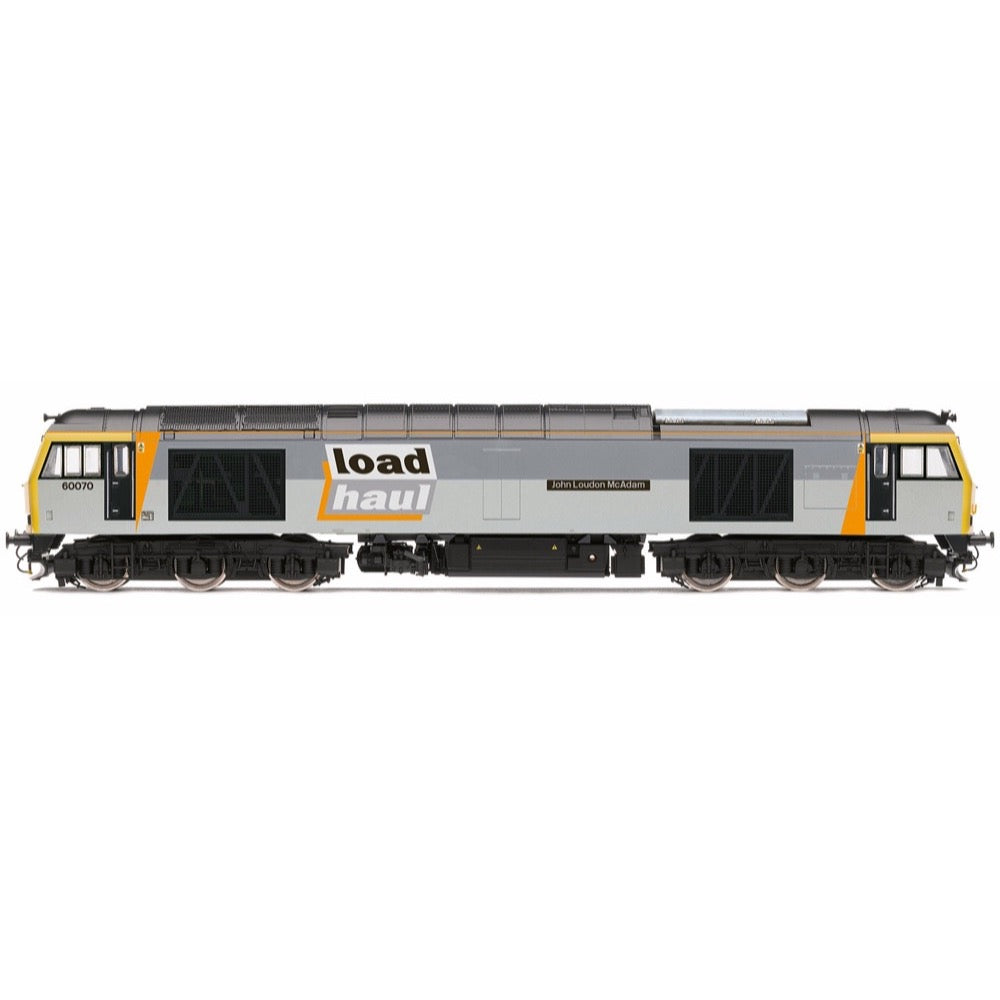
Hornby R3657 OO Loadhaul Class 60 Co-Co 60070 John Loundon McAdam Era 9
60070 John Loudon McAdam was built at Brush Traction's works in October 1991 and named on October 28, 1991.
Along with 60050 and 60064, 60070 John Loudon McAdam was one of only three locomotives to carry the Loadhaul branding over the existing Rail freight triple grey livery, rather than the more familiar black with yellow ends.
60070 was put into storage on August 31, 2004 and is currently stored at DB Schenker's Toton site.
Specification
- Item Scale: 1:76 Scale 00 Gauge
- Finish: Painted
- DCC status: DCC Ready 8 pin socket
- Wheel arrangement: Co-Co
- Minimum radius curve: Radius 2
- Motor: 5 Pole Skew wound
- Coupling: NEM
- Designer: British Railways
- Operator: Loadhaul
- Livery: Two-Tone Grey
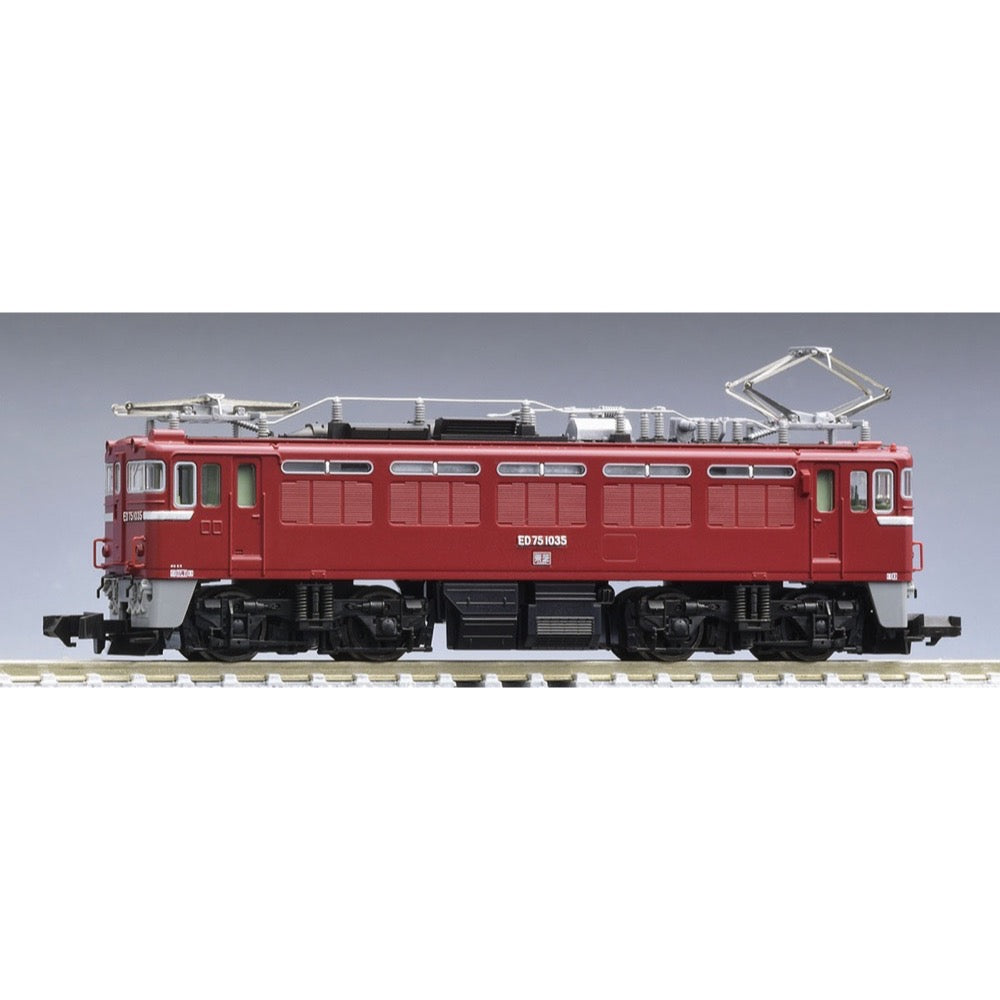
Tomix N ED75-1000 Later Type
The ED75 series is an AC electric locomotive that appeared in 1963.
The 1000 series was introduced in 1968 to pull high-speed freight trains and 20-series passenger cars, and 39 were manufactured.
Cars from 1026 onwards are called later models, and their appearance has changed, with the front ventilation holes gone, block-type license plates adopted, and taillights fitted on the outside.
All 1000 series locomotives were assigned to the Aomori Locomotive Depot, and except for some early-model cars that were later transferred to the Nagamachi Locomotive Depot, they remained there until the privatization of the Japanese National Railways, where they were mainly used to pull express trains and freight trains on the Tohoku Main Line and Joban Line.
Features
- Reproduce the late model number 1026 and later among the ED75-1000 types
- The side window of the driver's cab reproduces the appearance of H rubber
- See-through representation of the cab
- H rubber is reproduced in gray
- Front handrail (vertical) is included as a separate part
- Separate parts are attached to the release lever
- Number plate comes with separate parts [ED75-1027/1029/1033/1035]
- Two head marks “Yuzuru” are included.
- Headlights are equipped with a constant lighting board and an ON-OFF switch
- Headlights are lit by bulb-colored LEDs
- Signal flame tube and whistle are included as separate parts
- Powered by flywheel
- Adopts black truck frame and black wheels
- Uses wheels with box center wheels
- Dummy coupler/self-linked TN coupler included
- M-13 motor adopted


